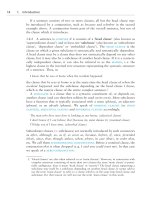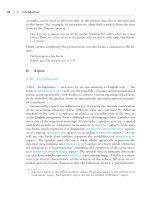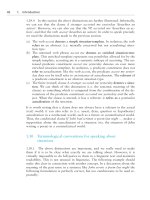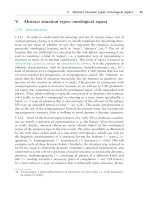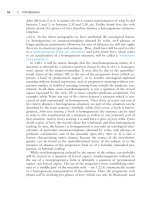The grammar of the english verb phrase part 73 pptx
Bạn đang xem bản rút gọn của tài liệu. Xem và tải ngay bản đầy đủ của tài liệu tại đây (164.57 KB, 7 trang )
IV. T-relations in a post-present domain 497
the fact that the two situations do not really overlap but concentrates on the
fact that they follow each other closely and that there is some logical relation
between them. The use of a tense form whose basic function is the expression
of T-simultaneity then means that the speaker treats the two situations as be-
longing to the same ‘occasion’ and hence as falling within the same time in-
terval.
10
Another clear illustration of such a use is provided by examples like
the following, where the relevant verb form is a form whose basic meaning is
the expression of simultaneity, viz. a present participle:
Opening the drawer, he took out an old photo of a man in uniform.
Raising the lid of the well, she pointed to the green water.
The locomotive jumped the rails, narrowly missing a couple of trees near the railway.
In these examples, the situation referred to in the present participle clause
either precedes (in the first two examples) or follows (in the third example) the
head clause situation.
The fact that verb forms expressing T-simultaneity can be used in a sloppy
way illustrates the fact that T-simultaneity is the unmarked relation of the three
that can be expressed by verb forms. This is especially clear in conditional
sentences referring to the post-present, where the expression of a temporal
relation between the two clauses is less important than the expression of the
logical link (‘if p, then q’). In such conditional sentences the if-clause is there-
fore likely to use a tense form expressing T-anteriority only if it contains a
time adverbial like by 5 o’clock (as in I will punish you if you haven’t finished
by 5 o’clock). Otherwise, it normally involves a tense form expressing simulta-
neity. This may even be the case when the two clauses contain adverbials refer-
ring to different times, as in If John doesn’t do it today, I will do it myself
tomorrow. In such a sentence the speaker represents the two situations as if
simultaneous if he is just thinking of them as two post-present situations that
are logically connected with each other.
11
It is only when he wants to draw
explicit attention to the fact that one situation is over before the other takes
place that he selects the verb form expressing anteriority (If John hasn’t done
it today, I will do it myself tomorrow).
10. In fact, this also holds for the absolute use of the present tense, which represents a
situation as T-simultaneous (ϭ coinciding) with t
0
. Leech (1971: 3) points out that the
‘instantaneous’ use of the present tense does not require that the situation be strictly
simultaneous with t
0
. A sentence like Now I open the envelope may be uttered seconds
before the action takes place. As Leech points out, “it is subjective rather than objective
simultaneity that is conveyed”.
11. The fact that conditional sentences represent the contents of the two clauses as simulta-
neous is also apparent from the fact that the head clause can be introduced by then (e. g.
If John doesn’t do it, then I’ll have to do it myself tomorrow). This use of then may not
be purely temporal, but it is reminiscent of the temporal meaning of the adverb, which
is ‘at that time’, i. e. ‘at the time referred to in the if-clause’.
498 9. Temporal subordination in the various time-zones
9.21 T-simultaneity with an orientation time coinciding
with the central orientation time
A time that is T-simultaneous with a pseudo-t
0
, or with another time that is T-simulta-
neous with a pseudo-t
0
, also functions as a pseudo-t
0
.
When a situation time is represented as coinciding with a pseudo-t
0
(i. e. the
central orientation time of a post-present domain), that situation time can be the
binding orientation time for another situation time. In that case the relation of T-
simultaneity (coincidence) is also expressed by the present tense. This means that
not only the central orientation time of a post-present domain but also any situa-
tion time that is represented as T-simultaneous with it is treated as a pseudo-t
0
.If
such a pseudo-t
0
binds another situation time, the latter will therefore be referred
to by one of the four pseudo-absolute tenses. In the following examples the tense
forms referring to the bound situation time are italicized, whereas the binding
situation times (which are also bound pseudo-t
0
’s because they are each repre-
sented as coinciding with another pseudo-t
0
) are underlined:
I’ll give a fiver to anyone I meet while I am there and who says he is glad to meet me.
They will find out that Jack thinks that he was born in London.
[If we don’t hide this letter from Gladys] she will go and tell everybody that she
knows why Tim has been fired.
[Do not inform Jack, or] he will tell the police that he knows that a murder will
be committed.
The tense structure of (the relevant part of) the last example is represented by
Figure 9.11.
Figure 9.11. The tense structure of [Do not inform Jack, or] he will tell the police that
he knows that a murder will be committed.
IV. T-relations in a post-present domain 499
E. The expression of T-posteriority in a post-present
domain
9.22 T-posteriority in a post-present domain
To represent a situation time as T-posterior to t
0
we use the future tense or a futurish
form. This means that the situation time in question is represented as a pseudo-t
0
functioning as the central orientation time of a pseudo-post-present subdomain.
Predictably, to represent a situation time as T-posterior to the central orienta-
tion time, or to any other pseudo-t
0
in the post-present domain, we use the
same tense as is used to represent a situation time as T-posterior to (the real)
t
0
, viz. the future tense (or one of the ‘futurish’(see 2.9) verb forms). This tense
form is then used as a pseudo-absolute tense form, which locates its situation
time in the ‘pseudo-post-present’ and in doing so creates a ‘pseudo-post-present
subdomain’ within the post-present domain.
He will swear that he will never tell her the ugly truth.
[When I’m throwing my own party next month] I’ll be able to tell you whether there
{will / is going to} be a display of fireworks after the speeches, [but this time I
don’t know].
In the same way as a situation time that is posterior to t
0
is treated as if it
were t
0
, any situation time that is represented as T-posterior to such a pseudo-
t
0
is also treated as a pseudo-t
0
when another situation time is related to it.
This means that the latter situation time is located in one of the four pseudo-
absolute zones:
She will think that John will tell the others {that he was here tonight / that he has
not told them the truth yet / that he is dissatisfied with their behaviour / that he
will tell them the truth later}.
Figure 9.12 represents the tense structure of this sentence when will tell is used
in the final clause.
This use of the future tense to establish a pseudo-t
0
can repeat itself indefi-
nitely. Any situation time that is T-posterior to a pseudo-t
0
functions as a
pseudo-t
0
itself. This can produce structures with multiple pseudo-t
0
’s, such as
the following (in which each pseudo-t
0
is underlined):
Shirley will think that John will find out that Ted will tell Susan {that he was here
tonight / that he has not told her the truth yet / that he is dissatisfied with her
behaviour / that he will tell her the truth later}.
500 9. Temporal subordination in the various time-zones
Figure 9.12. The tense structure of She will think that John will tell the others that he
will tell them the truth later.
9.22.1 Examples can be found in which the post-present domain is estab-
lished indirectly
by a tense form expressing a T-relation within the domain:
Yesterday Sheila said she would be abroad when our wedding takes place.
In this example the situation times of said and would be are located in a past
domain, while the situation time of takes is located in a post-present domain.
The latter is not established ‘directly’ (i. e. by a future tense or futurish verb
form whose situation time is the central orientation time of a post-present
domain) but by the use of a form representing its situation time as coinciding
with the unspecified central orientation time of the domain. This is possible
because the situation time of would be abroad is meant to be interpreted as
W-posterior to t
0
, so that would be abroad evokes ‘will be abroad’.
The use of the present tense in examples like the following can probably be
explained in a similar way:
I don’t care if he {is /*will be} exhausted tomorrow.
As noted in 10.7.1, the future tense cannot be used in clauses expressing an
open condition (i. e. a condition which may or may not be fulfilled in the
future: I will be sad if she {doesn’t get /*won’t get} that job). The same rule
appears to be at work in I don’t care if he {is /*will be} exhausted tomorrow.
Here the post-present domain is established indirectly by is, which represents
the being exhausted as T-simultaneous with a central orientation time which
is specified only by virtue of being ‘contained’ in the Adv-time indicated by to-
morrow.
It is possible that the same analysis is also applicable to sentences like the
following, in which the present tense can be used as an alternative to the fu-
ture tense:
IV. T-relations in a post-present domain 501
I hope our train {isn’t / won’t be} late again today.
IbetI{get / will get} there before him.
However, it is equally possible that the use of the present tense here represents
a ‘shift of temporal perspective’ similar to what we observe in It doesn’t matter
what we do Ϫ see 10.6.2.
9.23 The theoretical status of pseudo -abso lute tense forms
9.23.1 It has been shown that, in a post-present domain, any T-relation be-
tween a bound situation time and the binding post-present pseudo-t
0
is ex-
pressed by exactly the same tense as T-relates a situation time to the real t
0
.
The only difference is that in the latter case the tenses are absolute tenses
establishing domains, whereas in the former case they are pseudo-absolute
tenses establishing (pseudo-absolute) subdomains. Because in doing so they
express a T-relation in a post-present domain, we might feel tempted to say
that these pseudo-absolute tenses are relative tenses, but it would not be correct
to do so. That is, it would be mistaken to conclude that next to the absolute
present tense there is a relative present tense, and similarly, that there are two
different present perfect tenses and two different post-present tenses.
Pseudo-absolute tenses result from applying a ‘shift of perspective’, i. e. from
locating a situation time in an absolute time-zone that is different from the one
in which it would naturally be located. Treating a post-present situation time
as if it were t
0
is similar to treating a past situation time as if it were present,
as in the historic present, or to treating a pre-present situation time as if it
were present, as in I hear you have been promoted, or as treating the central
orientation time of a domain established by an indefinite present perfect as if
it were a past orientation time when the domain is expanded, as in I’ve never
told you before that you were very talented. In each case a situation time is
treated as if it were a situation time belonging to a different absolute time-
zone from the one that it would naturally be located in. This is done by a
marked choice of tense, i. e. by a tense which is not used with its basic meaning
but in a metaphorical way. In the same way the use of a pseudo-absolute tense
to expand a post-present domain is a metaphorical use of an absolute tense.
By contrast, there is usually nothing metaphorical about the use of relative
tenses, i. e. the past perfect, the relative past tense, the conditional tense and
the conditional perfect tense. (The latter are used metaphorically only if they
are used to expand a pre-present domain as if it were a past one.)
It follows that speaking of ‘pseudo-absolute tenses’ is really a sloppy way
of speaking of ‘the pseudo-absolute use of tenses whose basic use is absolute’.
For example, there is only one present perfect tense, but it has two uses because
it can locate a situation time either in the pre-present zone, which leads up to
502 9. Temporal subordination in the various time-zones
t
0
, or in a pseudo-pre-present period leading up to a post-present pseudo-t
0
.
By contrast, as far as past tense forms are concerned, there are two past tenses,
the absolute one and the relative one. (See the elaborate defence of this claim
in 8.23Ϫ32.) The relative past tense is used in one sense only, viz. to express
the idea that the time of the situation referred to is T-simultaneous with a
binding time which forms part of a past (or pseudo-past) domain or subdo-
main Ϫ see 2.44. The absolute past tense has two uses: in its basic (nonmeta-
phorical) use it locates a situation time in the past relative to t
0
, while in its
metaphorical use it locates a situation time in the past relative to a post-present
pseudo-t
0
. These different uses are illustrated by the following sentences:
He didn’t have the time to do it. (unmarked use of the absolute past tense)
[If he doesn’t do it] his explanation will be that he didn’t have the time to do it.
(pseudo-absolute use, i. e. metaphorical use of the absolute past tense)
He realized he didn’t have the time to do it. (unmarked use of the relative past tense
expressing T-simultaneity)
[If he doesn’t do it] his explanation will be that when he made his promise, he
didn’t realize that he didn’t have the time to do it. (relative past tense expressing T-
simultaneity in a pseudo-past subdomain inside a post-present domain)
9.23.2 The use of the present tense as pseudo-absolute tense is not based on
the same kind of metaphor as we observe in I’m leaving tomorrow, where the
present tense is also used to make it clear that the post-present situation time
is treated as if it coincided with t
0
(see 2.20). In the case of the pseudo-absolute
use of the present tense (e. g. [If you go there] you will have to tell the security
man why you want to be there) there is clearly a shifted deictic centre relative
to which the present tense locates a situation as ‘present’. In I’m leaving tomor-
row the present tense can be seen as locating the situation time at t
0
in order
to be understood as ‘arranged at t
0
’. These are two different metaphorical uses,
and it is therefore not surprising that they can be combined, as in He will say
that he’s leaving the next day. (See 10.2.3 for further explanation.)
9.24 Subdomains and recursivity
It should be clear from the previous sections that some of the rules involved in
the English tense system apply recursively. This is true, for example, of the
rules for expanding a past domain. Once a past domain has been established,
a relative tense that expresses a relation in this domain can be said to create a
subdomain within the past domain. Any situation time introduced into a past
domain is therefore potentially the central orientation time of a past subdo-
main, which is developed in exactly the same way as the over-all domain. This
accounts for the fact (noted in 8.34) that the relative tense used for expressing
IV. T-relations in a post-present domain 503
a particular T-relation in a past domain is always the same, irrespective of the
location of the binding orientation time in the domain. For example:
John said that Bill had told him that he would resign if he did not get his way.
As shown in Figure 9.13, each of the tense forms here creates a past domain
or subdomain. Each of the temporal relations in the domain is a relation be-
tween the central orientation time of a subdomain and the central orientation
time of the (sub)domain into which it is temporally embedded.
Figure 9.13. The tense structure of John said that Bill had told him that he would
resign if he did not get his way.
There is also recursivity in post-present domains. The rule stipulating that
the central orientation time of a post-present domain is treated as if it were t
0
applies recursively in the sense that an orientation time represented as coincid-
ing with or posterior to that pseudo-t
0
is also treated as a pseudo-t
0
, and that
the same is true of any other orientation time represented as T-simultaneous
with or posterior to a pseudo-t
0
Ϫ see Figure 9.11 in section 9.21.
9.25 Relating a situation time to the situation time of a
future perfect
As noted in 2.47, the future perfect is an ‘absolute-relative’ tense because it
establishes a post-present domain and at the same time expresses anteriority in
it. The anteriority in question is similar to either the anteriority to t
0
expressed
by the absolute past tense or the anteriority to t
0
expressed by the present
perfect. Compare:



